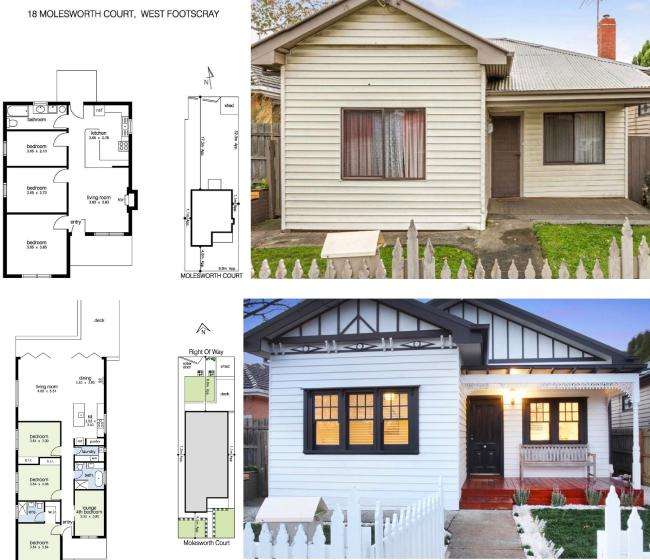Flipping houses is the Australian dream. In this dream, superior intuition about the real estate jungle allows you to trade like a jaguar — swift, smart and opportunistic. You buy low, sell high. Pinpoint renovations in hot suburbs gift you bountiful returns. Profits start to get crazy. It has been the same in New Zealand during the boom years.
For example, a home in Melbourne’s inner west bought in 2016 for $660,000 and given a tasteful renovation was moved on for $1.27 million a year later.

Clearly they spent a lot of money on the renovation, but there would still have been a tidy profit on this reno. Picture: Realestate.com.au
Start your property search
But flipping is easy when prices are rising.
Now prices are falling in once-reliable and lucrative parts of Australia. Homes sold for less than was paid are not hard to find if you sniff around in the sold section of major real estate websites. Especially among apartments.
With prices falling, some flippers are floundering.
“When the market is down as it is in a lot of states, what it technically means is that you become less wealthy on paper. And you just have to be able to ride it through to the next cycle,” says Cherie Barber, the proprietor of Australian business Renovation For Profit.
Barber made her name buying properties, tarting them up and moving them on for a good return. She is reportedly worth millions, and has thousands of “students” across Australia. But now she teaches a different strategy.
“Try to hold on to your stock if you can,” she says. “Resist the urge to sell … what ultimately makes you wealthy is long-term capital growth, in addition to the growth you manufacture in the renovation.”
House flippers are the canary in the coal mine for property because they buy and sell so fast. Only if the work they have done on the house has added more value than it cost will they come out ahead. And even then, the extra has to cover stamp duty, agents fees, property sale costs, and the rest. If it doesn’t, holding on for longer is the only solution.
While fast capital gains were underpinning the market, it was easy to make that margin. Now, not so much. No wonder long-term hold is now the mantra.
The question is how long prices can fall. The most dire example of big falls in recent Australian history is Perth. There, you can find a flat in East Perth that sold for $530,000 in 2010, but was worth just $390,000 last month.
Another inner city flat fell in value to $260,000 from its original price of $276,000 in September 1999.
There are many like it and they are not all flats. This $2.2 million home in Cottesloe (2007 price) became a $1.9 million home when it was sold in 2018.
Barber says some of her students are going backwards. But she has faith in the long-term capital gains.
“I have students in Perth who have been holding stock, now technically yes on paper they are poorer now than what they were four years ago as a result of those properties falling out, she says. “but if they hold onto those properties, the Perth property market is at the absolute bottom of the cycle and in fact I believe it has begun to swing into the next stage, the recovery stage … Whether it will go back to the degree that it was, I don’t know.”
Flippers can make big returns. But where there is return there is always risk. The risk for Australia is that this property price crash puts more people under water than just a few flippers.
















































































